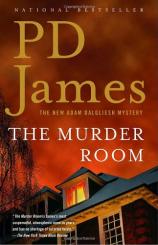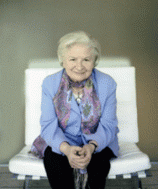The Murder Room: An Adam Dalgliesh Mystery
Review
The Murder Room: An Adam Dalgliesh Mystery
The Golden Age of female crime writers like Agatha Christie, Dorothy L. Sayers, Margery Allingham, Josephine Tey and Ngaio Marsh was over by the early 1960s. As a matter of fact, by then the whole mystery genre was suffering a slow death. After all, the exploding culture of the swinging sixties was the benchmark of social changes ranging from sexual freedoms to movements for civil and women's rights, to the manner of dress and the kind of music that was beginning to help change the world. This phenomenon left the genteel novels that took place in English country homes, populated by the upper classes and very "clean" murders, dying on the vine.
Then, in 1962, P. D. James published her first book and reinvented the mystery genre. No longer would readers be satisfied with 'the butler did it' tales; rather, James broke the old mold and fictionalized urban crimes committed by psychopaths, miscreants, and the ordinary 'nutter' who lived next door. "I think in the modern detective story ... the effects of the crime are a great deal more disruptive than they were in the older mystery ... [and] the modern detective story shows how ... contaminating murder can be and how no life in that society ... is untouched by it," opines James.
As a writer P. D. James tells her stories in words and actions that reflect what real life people would do, if s/he found her/himself in the same situation. For example: Commander Adam Dalgliesh, dedicated policeman and respected poet, is erudite, smart and handsome, but he is also in important ways an "everyman." He is as believable a hero in the drawing rooms of the very rich as he is talking to working classes. He is not an amateur sleuth but a real working cop. He will view a body differently from the way a civilian would see it. In creating this distinction James sets her players and their psyches apart from the mundane and banal found in much genre work. She transcends the usual clichés because she gets to the heart of her characters as they move toward the heart of the mystery.
In all of James's novels, setting, place and the building where the murder occurs is part of the foundation upon which she builds her tales. Readers are told about the architecture and what it housed in the past. In her latest mystery, THE MURDER ROOM, she chose an out of the way structure. "Dalgliesh stopped the car and gazed in silence." Beyond the shrubs "stood a symmetrical red-brick house, elegant, architecturally impressive and larger than he had expected. A white painted door, glass-paneled, was set in an intricate pattern of brickwork. The restraint and complete symmetry ... gave the house a ... forbidding air, more institutional than domestic." But ornate brickwork "gave a note of eccentricity to a façade which might otherwise have been formidably uniform."
Dalgliesh's companion tells him that the structure was built by a prosperous Victorian factory owner in 1894 who copied a structure that had been built in 1636 by an eccentric architect named Indigo Jones. Dalgliesh thought it was somewhat intimidating, but his companion was eager to get inside.
The Dupayne Museum is a private institution dedicated to the years between the wars, 1919-1939. But as the novel begins, the museum is in trouble. "The whole future of this place is in doubt. The lease runs out next month ... [Max Dupayne, the eccentric founder] drew up a curious family trust ... the museum can only continue if all three of his children agree to sign [a new] lease." And of course one of them is adamant about not keeping the place going. He is Neville Dupayne, the second son; a psychiatrist who is divorced and only has contact with his unstable daughter when she needs money. On the day Dalgliesh visits he has an argument with ... "James Calder-Hale, curator and presiding genius of the facility ... goading the old man [into chastising him and reminding] him ... the Dupayne, like any reputable museum, provides for the safe custody, preservation, recording and display of items of interest from the past for the benefit of scholars and other interested enough to visit."
Max Dupayne was a man obsessed with the inter-years and he began collecting in the 1920s through the 1930s ... "which accounts for some of the pictures; he was able to buy before the artist attracted big money. He also acquired first editions of every major novelist ... [and] the library is pretty valuable now." But what attracted most people to the museum was "the murder room" which is "at least thirty feet long and well lit ... there displayed, illustrated and examined, were the most notorious murder cases of the inter-war years. The impression was of a collage of blood and blank dead faces, of murderers and victims united now in death, staring at nothingness."
The first murder is committed on the grounds of the Payne, a most horrific crime that appears to be copied from one of the most notorious chronicled in the Murder Room. The next murder is committed inside the walls of the museum. It, too, is a recreation of a heartbreaking murder also profiled in the Murder Room. An artifact that is supposed to have been part of that killing is one of the most popular attractions offered to patrons.
From these threads P. D. James weaves a fascinating tale of boiling tempers, sibling rivalries, upper-crust snobbery, greed and myopic visions. Through the museum readers can see how murder, in context, reflects the social history of the time in which it was committed. The author also touches on whether people live too much in the past. She questions whether or not people become stunted when they live insulated lives dedicated to the study of arcane and devilish deeds committed long ago. She wonders if these individuals can ever escape the walls they have chosen to live behind.
In every one of her novels James has spared nothing in attending to details. She describes her characters from their eye color to the definition of a cheekbone, illuminating them with her psychological insights and sharing with the reader their elemental personalities. All of this makes them real to readers who are then able to care about them and eager to discover their fate. This gift helps rivet fans to her books and has made her a provocative writer whose approach to mystery writing may be classical in some ways but in others is purely of her own devising. In an interview she said, "I ... discovered that within the detective form I could write a novel that has a moral ambiguity and psychological subtlety like a serious novel. Writing within the constraints isn't in fact inhibiting; it's positively liberating! Many of my books are --- well, they're to do with death --- but they're also to do with love, different aspects of human love."
Since 1962 she has written eighteen books, a play, and a memoir. She has created Baroness James of Holland Park, has won too many awards to name, and her peers say things like this about her: "Anita Brookner ... calls James an 'addictive writer' who tells a 'story as satisfying as it is complete. Joyce Carol Oates applauds her work for the complexity of its characters." Most of her books have been translated into films, which Americans are privileged to be able to see on local PBS stations. These have made her and Adam Dalgliesh household names and are excellent viewing fare.
And at eighty-three Baroness James is still vibrant and active. Perhaps THE MURDER ROOM is her most intellectually challenging book. It certainly reinforces what fans and critics have known about her for the past forty years as a writer: P. D. James has always written from the heart and her novels are treasures that will endure.
Reviewed by Barbara Lipkien Gershenbaum on January 22, 2011










